A number of systems on today’s heavy duty vehicles utilize compressed air, including air brakes – both drum and air disc, anti-lock braking systems, electronic stability control, suspension controls such as air ride, and more.
In addition, other vehicle systems such as emission controls and automated manual transmissions (AMTs) are now connecting to the compressed air system of a vehicle. AMTs in particular require very clean air to control the solenoid valve that completes the shifting process.
“Emission dosing valves and AMTs are really great technology," says Jason Kraus, senior manager of air systems for Meritor. "However, they require a super clean flow of air to operate properly. If you don’t maintain that clean air flow, you’re going to have contamination. And a lot of expense will [occur] to repair or replace those impacted items.”
Meritor is the official distributor of Meritor Wabco products, including air dryer filtration products.
There are two types of air dryer filtration cartridges that can be mated to the air dryer itself: traditional and oil coalescing.
Traditional, or standard, air dryer filter cartridges aid in removing water vapor from the air line. Oil coalescing air dryer filter cartridges not only remove this water vapor, but also have the ability to remove oil aerosols and other small contaminants.
The removal of oil aerosols aids in providing extremely clean air for the newer technology developments in emissions and transmission systems. Kraus says oil coalescing cartridges allow for the removal of 99.9 percent of oil aerosol particles and other contaminants from the air line before it enters these vehicle systems.
Oil aerosol hasn’t always been an issue. With the introduction of more efficient engines circa 2010, engines began running hotter.
“Those engines have created the aerosol – they run a lighter weight of oil,” Kraus explains. “They are more fuel efficient, no doubt about it. But because they’re more fuel efficient, they run hotter, [with] additives added, it allows an atomization of the oil – an aerosol – that if you don’t have the proper filter media in the oil coalescing cartridge, [the oil will]l go right through a standard cartridge and get to the air tanks and go through all the air lines.”
Suggested replacement intervals
“Subsequently, because they’re very astute at collecting those contaminants, you have to replace them more frequently,” Kraus says of oil coalescing air dryer filter cartridges, compared to traditional air dry filter cartridges.
Suggested replacement intervals of the filter are dependent on filter cartridge brand and vehicle application.
- For on-highway and long haul applications, standard cartridge replacement ranges from about every two to three years.
- For on-highway and long haul applications, oil coalescing cartridge replacement ranges from every one to two years.
- For severe duty applications, standard cartridge replacement ranges from one to two years.
- For severe duty applications, oil coalescing cartridge replacement ranges from six months to one year.
As always, if OEM replacement guidelines are more frequent than those listed above, those guidelines should be followed.
Indicators of an air dryer system issue
A number of indicators may lead to issues with the air dryer system. Kraus advises that technicians or drivers may see oil leakage, or more frequent replacement of valve or seal components (one example was a refuse fleet vehicle needed ABS valve replacement six times in one year, says Kraus).
Ultimately, maintenance on the system is key. However, Kraus notes fleets may evaluate current vehicles to determine the viability or necessity of switching from standard to oil coalescing air dryer cartridges.
“Replacing with an oil coalescing cartridge will stop future oil leakage, but it will not clean up the systems already affected," he says. "It can be very expensive to service or clean up the systems impacted – replacing all the valves, the air tank, the hose assembly and air lines. That’s very expensive to do that cleanup.”




